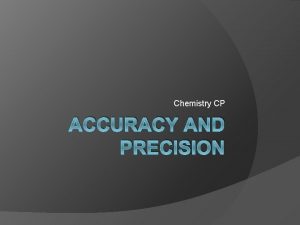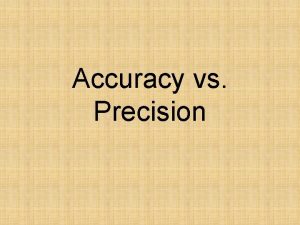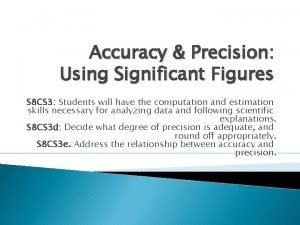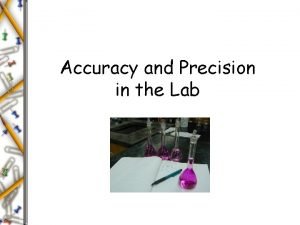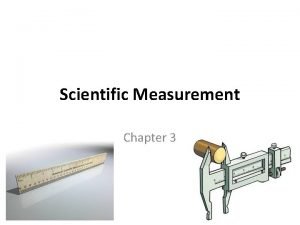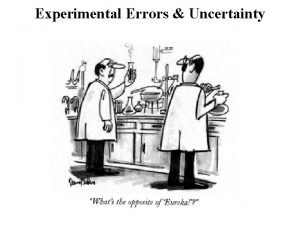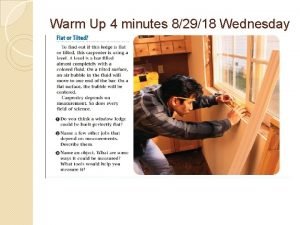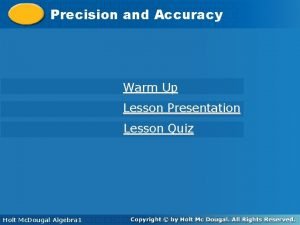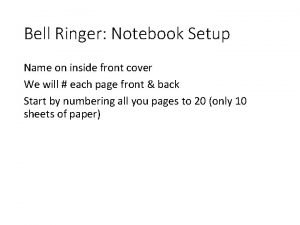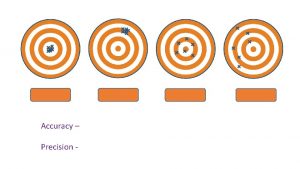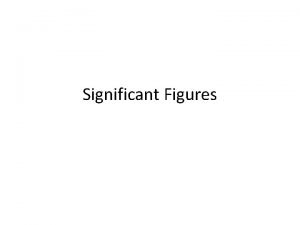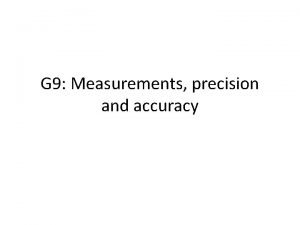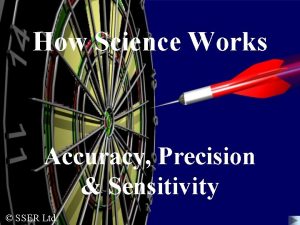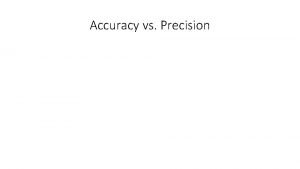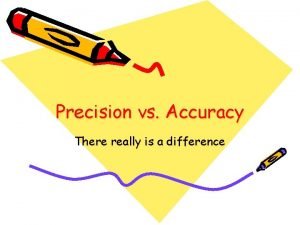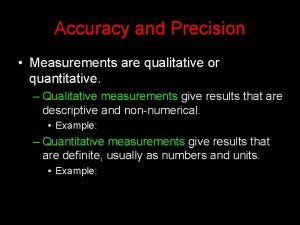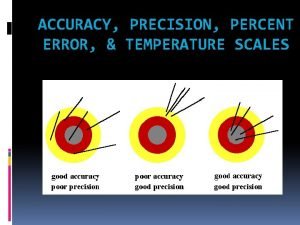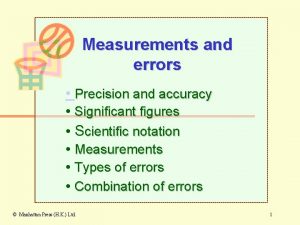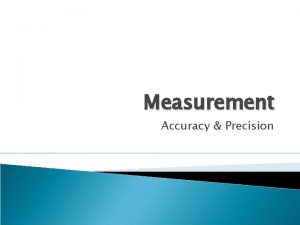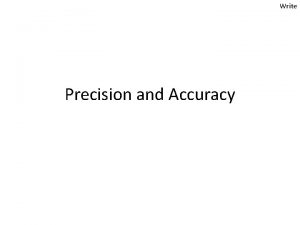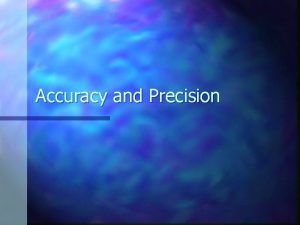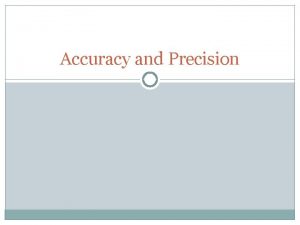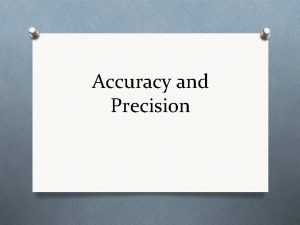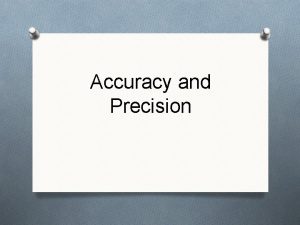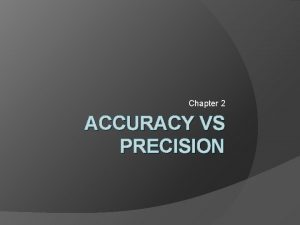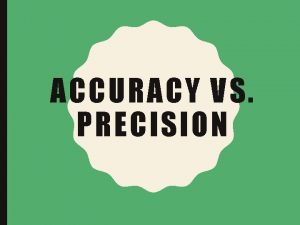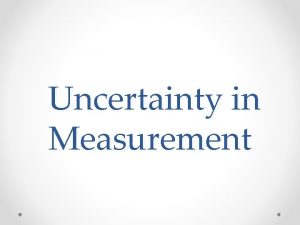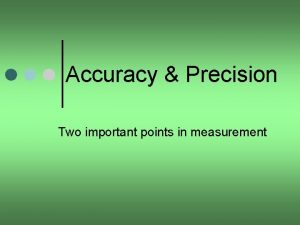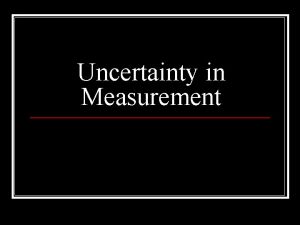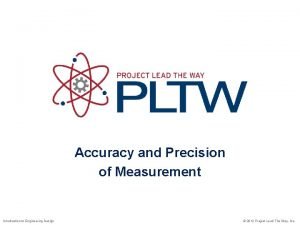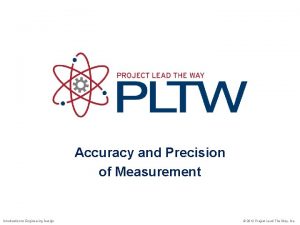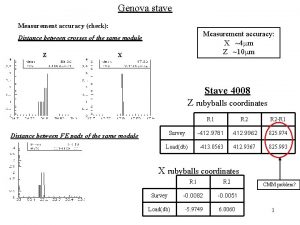Accuracy and Precision of Measurement Introduction to Engineering

























- Slides: 25

Accuracy and Precision of Measurement Introduction to Engineering Design © 2012 Project Lead The Way, Inc.

Recording Measurements • A measurement always includes a value • A measurement always includes units • A measurement always involves uncertainty – A measurement is the best estimate of a quantity – A measurement is useful if we can quantify the uncertainty

Sources of Error in Measurement • Potential errors create uncertainty • Two sources of error in measurement – Random Error • Errors without a predictable pattern • E. g. , reading scale where actual value is between marks and value is estimated • Can be determined by repeated measurements – Systematic Error • Errors that consistently cause measurement value to be too large or too small • E. g. , reading from the end of a meter stick instead of from the zero mark

Uncertainty in Measurements • Scientists and engineers often use significant digits to indicate the uncertainty of a measurement – A measurement is recorded such that all certain digits are reported and one uncertain (estimated) digit is reported

Uncertainty in Measurements • Another (more definitive) method to indicate uncertainty is to use plus/minus notation – Example: 3. 84 ±. 05 cm • 3. 79 ≤ true value ≤ 3. 89 • This means that we are certain the true measurement lies between 3. 79 cm and 3. 89 cm

Uncertainty in Measurement • In some cases the uncertainty from a digital or analog instrument is greater than indicated by the scale or reading display – Resolution of the instrument is better than the accuracy • Example: Speedometers How can we determine, with confidence, how close a measurement is to the true value?

Uncertainty in Measurement • Uncertainty of single measurement − How close is this measurement to the true value? − Uncertainty dependent on instrument and scale • Uncertainty in repeated measurements − Random error − Best estimate is the mean of the values

Accuracy and Precision • Accuracy = the degree of closeness of measurements of a quantity to the actual (or accepted) value • Precision (repeatability) = the degree to which repeated measurements show the same result High Accuracy Low Precision Low Accuracy High Precision High Accuracy High Precision

Accuracy and Precision • Ideally, a measurement device is both accurate and precise • Accuracy is dependent on calibration to a standard – Correctness – Poor accuracy results from procedural or equipment flaws – Poor accuracy is associated with systematic errors • Precision is dependent on the capabilities of the measuring device and its use – Reproducibility – Poor precision is associated with random error

Your Turn Two students each measure the length of a credit card four times. Student A measures with a plastic ruler, and student B measures with a precision measuring instrument called a micrometer. Student A 85. 1 mm 85. 0 mm 85. 2 mm 84. 9 mm Student B 85. 701 mm 85. 698 mm 85. 699 mm 85. 701 mm

Your Turn Plot Student A’s data on a number line Plot Student B’s data on a number line Student A 85. 1 mm 85. 0 mm 85. 2 mm 85. 1 mm Student B 85. 301 mm 85. 298 mm 85. 299 mm 85. 301 mm

Your Turn Student A’s data ranges from 85. 0 mm to 85. 2 mm Student B’s data ranges from 85. 298 mm to 85. 301 mm The accepted length of the credit card is 85. 105 mm 85. 105 Accepted Value

Your Turn Which student’s data is more accurate? Student A Which student’s data is more precise? Student B

Quantifying Accuracy The accuracy of a measurement is related to the error between the measurement value and the accepted value mean of Error = measured values – accepted value Student A 85. 1 mm 85. 0 mm 85. 2 mm 85. 1 mm Student B 85. 301 mm 85. 298 mm 85. 299 mm 85. 301 mm

Quantifying Accuracy Calculate the error of Student A’s measurements Error A = mean of measured values – accepted value Error A = 85. 10 mm – 85. 105 mm = − 0. 005 mm Accepted 85. 105 Value Error - 0. 005

Quantifying Accuracy Calculate the error of Student B’s measurements Error B = mean of measured values – accepted value Error B = 85. 2998 mm – 85. 105 mm = 0. 1948 mm Accepted 85. 105 Value Error - 0. 005 Error 0. 1948

Quantifying Accuracy Calculate the error of Student B’s measurements Error B = mean of measured values – accepted value Error B = 85. 2998 mm – 85. 105 mm = 0. 1948 mm Accepted 85. 105 Value Error |-- 0. 005| = 0. 005 Error |0. 1948| 0. 1948 = 0. 1948

Quantifying Accuracy Calculate the error of Student B’s measurements Error B = mean of measured values – accepted value Error B = 85. 2998 mm – 85. 105 mm = 0. 1948 mm Accepted 85. 105 Value Student A MORE ACCURATE Error |-- 0. 005| = 0. 005 Error |0. 1948| 0. 1948 = 0. 1948

Quantifying Precision is related to the variation in measurement data due to random errors that produce differing values when a measurement is repeated

Quantifying Precision The precision of a measurement device can be related to the standard deviation of repeated measurement data Student A 85. 1 mm 85. 0 mm 85. 2 mm 85. 1 mm Student B 85. 301 mm 85. 298 mm 85. 299 mm 85. 301 mm Student A: s. A= 0. 08 mm Student B: s. B = 0. 0015 mm

Quantifying Precision Use the empirical rule to express precision • True value is within one standard deviation of the mean with 68% confidence • True value is within two standard deviations of the mean with 95% confidence

Quantifying Precision Express the precision indicated by Student A’s data at the 68% confidence level • True value is 85. 10 ± 0. 08 mm with 68% confidence § 85. 10 − 0. 08 mm ≤ true value ≤ 85. 10 + 0. 08 mm 85. 02 mm ≤ true value ≤ 85. 18 mm with 68% confidence

Quantifying Precision Express the precision indicated by Student A’s data at the 95% confidence level • True value is 85. 10 ± 2(0. 08) mm with 95% confidence § 85. 10 − 0. 16 mm ≤ true value ≤ 85. 10 + 0. 16 mm 84. 94 mm ≤ true value ≤ 85. 26 mm with 95% confidence

The Statistics of Accuracy and Precision A Low Accuracy High Precision C Low Accuracy Low Precision B High Accuracy High Precision D High Accuracy Low Precision

Gauge Blocks (Gage Blocks) • A block whose length is precisely and accurately known § Standard = basis of comparison • Precision measuring devices are often calibrated using gauge blocks § Calibrate = to check or adjust by comparison to a standard
 Define accuracy in chemistry
Define accuracy in chemistry Accuracy v precision
Accuracy v precision Precision and significant figures
Precision and significant figures The degree of agreement among several measurements
The degree of agreement among several measurements Poor accuracy good precision
Poor accuracy good precision Quick lab accuracy and precision answers
Quick lab accuracy and precision answers Accuracy and precision graphs
Accuracy and precision graphs Brainpop precision and accuracy quiz answers
Brainpop precision and accuracy quiz answers Lesson 1-3 reporting with precision and accuracy
Lesson 1-3 reporting with precision and accuracy Active and passive instrument
Active and passive instrument Precision and accuracy
Precision and accuracy 1-10 practice precision and accuracy
1-10 practice precision and accuracy Accuracy and precision
Accuracy and precision Accurate vs precise
Accurate vs precise Brainpop precision and accuracy quiz answers
Brainpop precision and accuracy quiz answers Sensitivity accuracy precision
Sensitivity accuracy precision Accuracy vs precision physics
Accuracy vs precision physics Precision vs accuracy chemistry
Precision vs accuracy chemistry Is accuracy qualitative
Is accuracy qualitative Pmi project quality management
Pmi project quality management Low accuracy low precision
Low accuracy low precision Temperature formula
Temperature formula Linear measurement devices
Linear measurement devices Semi precision attachment
Semi precision attachment Negatif sayıların binary gösterimi
Negatif sayıların binary gösterimi Accuracy in measurement
Accuracy in measurement
